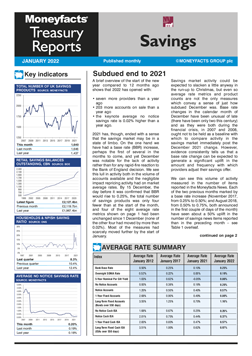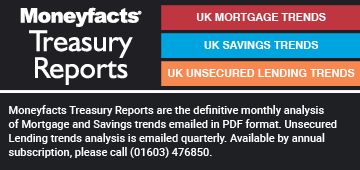Rachel Springall, Finance Expert at Moneyfacts, said:
“Savings choice rose year-on-year as there are now 203 more savings deals available for cash investors, however, there is a chance the market could further expand in the months ahead. Indeed, there were 145 more deals back in January 2020 before the savings market was rocked by the pandemic and subsequent base rate cuts in March 2020. In 2022 we could see more options launched to accommodate changing attitudes or needs. Those caught off guard by the pandemic’s influence on their financial resilience could well seek different types of accounts to suit different goals this year. Notice accounts, for example, could be a promising alternative to easy access, as they now pay the highest average rate seen since June 2020.
“The stabilisation with interest rates is evident, as all average savings rates have either risen or remained unchanged month-on-month, a stark contrast to rates hitting record lows last year. As was seasonably typical, there were fewer rate changes last month, but rate rises were more common than cuts, which is encouraging to end the year. The Bank of England’s decision to increase base rate has yet to make a significant impact to variable savings rates and, as we have seen before, this could take a few months to filter through. As was inevitable, the proportion of savings deals to beat base rate fell month-on-month, as base rose to 0.25%. However, there is no guarantee savers will see the 0.15% rise passed on, so it’s important they review their rate regularly.
“Longer-term fixed bond and ISA rates rose and stand at their highest levels since 2020, but one-year fixed bond and ISA rates remained unchanged month-on-month. Regardless, there remains a notable gap between the rate offered on a fixed bond versus an ISA. Comparing these rates and considering their existing Personal Savings Allowance (PSA) is essential for savers who routinely utilise their ISA allowance. The current levels of interest offered on cash savings accounts is unlikely to breach the PSA, unless savers have a substantial pot.
“Savers may well continue to put their cash in a flexible account this year, a trend which would echo that of 2021. According to the Bank of England, during November there was an inflow into sight deposits of just over £6 billion, which brings the total for January to November 2021 to £98 billion. Those savers who have their cash invested with a high street bank easy access account for convenience would be wise to compare rates with challenger banks and building societies instead, especially as some of the biggest banking brands pay as little as 0.01% today.”
Rachel Springall, Finance Expert at Moneyfacts, said:
“Savings choice rose year-on-year as there are now 203 more savings deals available for cash investors, however, there is a chance the market could further expand in the months ahead. Indeed, there were 145 more deals back in January 2020 before the savings market was rocked by the pandemic and subsequent base rate cuts in March 2020. In 2022 we could see more options launched to accommodate changing attitudes or needs. Those caught off guard by the pandemic’s influence on their financial resilience could well seek different types of accounts to suit different goals this year. Notice accounts, for example, could be a promising alternative to easy access, as they now pay the highest average rate seen since June 2020.
“The stabilisation with interest rates is evident, as all average savings rates have either risen or remained unchanged month-on-month, a stark contrast to rates hitting record lows last year. As was seasonably typical, there were fewer rate changes last month, but rate rises were more common than cuts, which is encouraging to end the year. The Bank of England’s decision to increase base rate has yet to make a significant impact to variable savings rates and, as we have seen before, this could take a few months to filter through. As was inevitable, the proportion of savings deals to beat base rate fell month-on-month, as base rose to 0.25%. However, there is no guarantee savers will see the 0.15% rise passed on, so it’s important they review their rate regularly.
“Longer-term fixed bond and ISA rates rose and stand at their highest levels since 2020, but one-year fixed bond and ISA rates remained unchanged month-on-month. Regardless, there remains a notable gap between the rate offered on a fixed bond versus an ISA. Comparing these rates and considering their existing Personal Savings Allowance (PSA) is essential for savers who routinely utilise their ISA allowance. The current levels of interest offered on cash savings accounts is unlikely to breach the PSA, unless savers have a substantial pot.
“Savers may well continue to put their cash in a flexible account this year, a trend which would echo that of 2021. According to the Bank of England, during November there was an inflow into sight deposits of just over £6 billion, which brings the total for January to November 2021 to £98 billion. Those savers who have their cash invested with a high street bank easy access account for convenience would be wise to compare rates with challenger banks and building societies instead, especially as some of the biggest banking brands pay as little as 0.01% today.”











